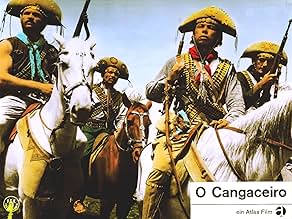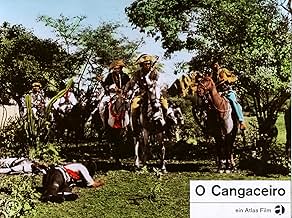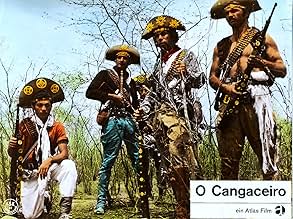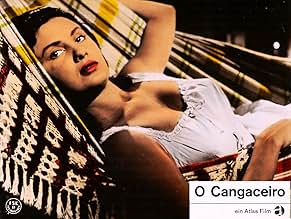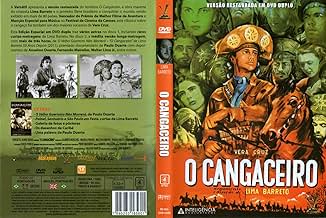Ajouter une intrigue dans votre langue'Capitão', a bandit, terrorizes poor villages in the Northeast region of Brazil, looting and frequently killing with his armed gang, until he kidnaps and becomes attracted to a beautiful sch... Tout lire'Capitão', a bandit, terrorizes poor villages in the Northeast region of Brazil, looting and frequently killing with his armed gang, until he kidnaps and becomes attracted to a beautiful schoolteacher, creating discord in his group.'Capitão', a bandit, terrorizes poor villages in the Northeast region of Brazil, looting and frequently killing with his armed gang, until he kidnaps and becomes attracted to a beautiful schoolteacher, creating discord in his group.
- Prix
- 2 victoires et 1 nomination au total
Avis en vedette
8driq
I saw this film at the Carnegie Cinema in NYC 50 years ago and still remember it. It was beautifully filmed. Aside from the plot, the background music, O Canganceiro which is played as an instrumental and choral is absolutely haunting. The female lead was exceptionally beautiful. As I recall, the film was a minor sensation at the time, but has since disappeared into the mists of history. Too bad. Is it available anywhere today?
(the 10 line minimum doesn't make sense. Why should I be forced to pad my comments when brevity is the soul of wit. This was a simple film,that doesn't require complex, "filomatic" critical comment!)
(the 10 line minimum doesn't make sense. Why should I be forced to pad my comments when brevity is the soul of wit. This was a simple film,that doesn't require complex, "filomatic" critical comment!)
I keep a very impressing souvenir of this picture I saw (6 times) in the fifties and would extremely appreciate if anyone could help me in finding a video copy. I much appreciated the crude and natural poetry of the film and,of course, the wonderful music. The photography also impressed me quite a lot and in my opinion Lima Barreto could have been influenced by Carol Reed. By all means, this film can certainly compete with the best "westerns" and should be given a chance to touch the actual generation by means of video, DVD etc. Although, since then, we have larger screens and color, this kind of picture in black and white proves, if necessary, that masterpieces exists without that.
In the times of the "cangaceiros" in the "sertão" (backcountry) in the North and Northeastern of Brazil, the cruel Capitão Galdino Ferreira (Milton Ribeiro) and his band abduct the school teacher Olívia (Marisa Prado), expecting to receive a ransom for her. However, one of his men, Teodoro (Alberto Ruschel) falls in love and flees with her through the arid backcountry chased by the brigands.
Along their journey, Olívia also falls in love with Teodoro and proposes him to leave the countryside and move to the city. But Teodoro loves also his land and tells that he would like to die in the backcountry where he was born.
"O Cangaceiro" is one of the best films of the Brazilian Cinema and the best produced by the Companhia Cinematográfica Vera Cruz. This film was written and directed by Lima Barreto, with dialogs of Rachel de Queiroz and is inspired in the story of the brigand Lampião and his band (http://en.wikipedia.org/wiki/Lampi%C3%A3o). The awesome cinematography in black and white discloses a magnificent introduction with backlight in the marauders.
On 12 May 1953, "O Cangaceiro" won the Cannes Film Festival in the category Best Adventure. In the wonderful soundtrack, highlights "Olê Muié Rendeira", sung by Vanja Orico. In accordance with the Wikipedia, this film was distributed by Columbia Pictures and sold to eighty (80) countries. It was exhibited in France for five consecutive years in the movie theaters. My vote is ten.
Title (Brazil): "O Cangaceiro" ("The Brigand")
Along their journey, Olívia also falls in love with Teodoro and proposes him to leave the countryside and move to the city. But Teodoro loves also his land and tells that he would like to die in the backcountry where he was born.
"O Cangaceiro" is one of the best films of the Brazilian Cinema and the best produced by the Companhia Cinematográfica Vera Cruz. This film was written and directed by Lima Barreto, with dialogs of Rachel de Queiroz and is inspired in the story of the brigand Lampião and his band (http://en.wikipedia.org/wiki/Lampi%C3%A3o). The awesome cinematography in black and white discloses a magnificent introduction with backlight in the marauders.
On 12 May 1953, "O Cangaceiro" won the Cannes Film Festival in the category Best Adventure. In the wonderful soundtrack, highlights "Olê Muié Rendeira", sung by Vanja Orico. In accordance with the Wikipedia, this film was distributed by Columbia Pictures and sold to eighty (80) countries. It was exhibited in France for five consecutive years in the movie theaters. My vote is ten.
Title (Brazil): "O Cangaceiro" ("The Brigand")
10joel-280
Like the few great sci-fi, western, and other genre films, O Cangaceiro transcends its genre to speak of integrity and how people deal with awful contradictions and dilemmas that develop in their lives. Sometimes unsuccessfully.
But don't let my fancy talk deter you; it's a great movie and if somehow you have a chance to see it, don't miss it. It is a three-star attraction (meaning, "worth a trip.")
To meet the IMDb's length requirement, I'll also note its poetic photography, deservedly famous background music, and the cool, restrained treatment (aided by the b&w photography) of deep emotions and tragic events.
But don't let my fancy talk deter you; it's a great movie and if somehow you have a chance to see it, don't miss it. It is a three-star attraction (meaning, "worth a trip.")
To meet the IMDb's length requirement, I'll also note its poetic photography, deservedly famous background music, and the cool, restrained treatment (aided by the b&w photography) of deep emotions and tragic events.
10elmar5
I saw this movie as an adolescent in the 60es just once on TV, but it still is one of only a handful which surface at least once every five years. As other reviewers have pointed out before, the great music by Zé do Norte was a major factor for this memorability. Foremost here is the ballad "Mulher Rendeira" (The Lacemaker), especially in the unforgettable scene when the gang rides in a duck line along a ridge which is set against the dusk sky and the gloomy grandeur of the Brazilian Sertao. In their leather garments, pepped up by the symbolism of amulets and talismans, the bandidos in this movie resemble an archaic tribe living in this land of dust and thorns for eons already. The movie is filmed in black and white which is lending it a certain kind of credibility reminding of a documentary. Although presenting a different plot, Barreto's movie was obviously inspired by the fate of the most famous couple of Brazilian cangaceiros, Lampiao and his wife Maria Bonita, who were killed in 1938 with seven others of their gang by the police.
Le saviez-vous
- AnecdotesThe very first Brazilian film to compete at the Cannes Film Festival.
- ConnexionsEdited into A Edição do Nordeste (2023)
Meilleurs choix
Connectez-vous pour évaluer et surveiller les recommandations personnalisées
Détails
- Durée
- 1h 45m(105 min)
- Couleur
- Mixage
- Rapport de forme
- 1.37 : 1
Contribuer à cette page
Suggérer une modification ou ajouter du contenu manquant

